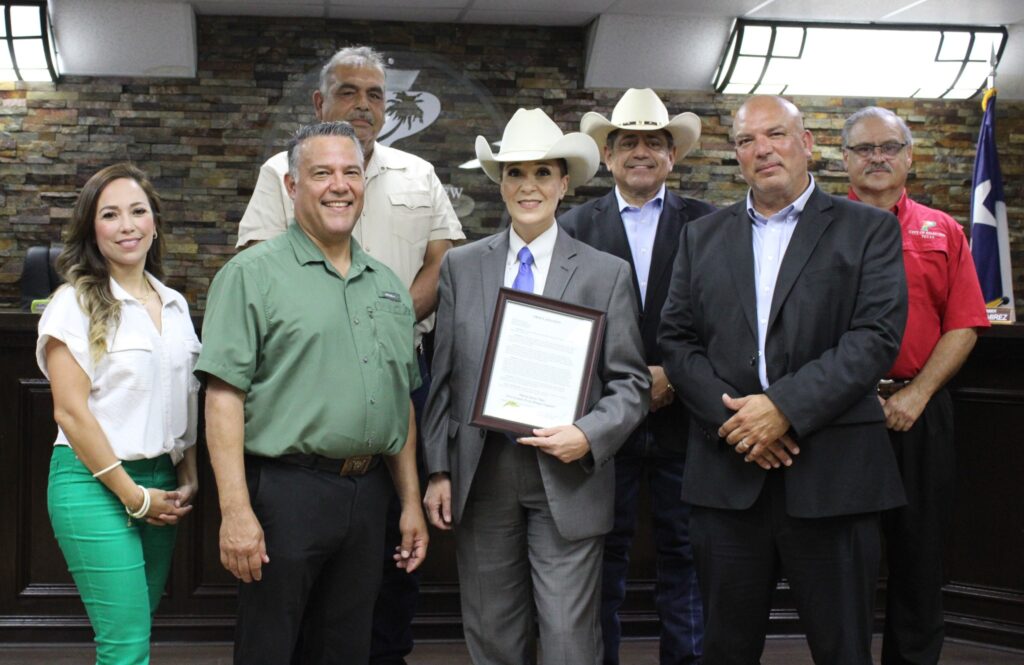
PALMVIEW, Texas- Mayor Rick Villarreal and the Palmview City Council have designated August 2, as Melba Saenz Day in honor of her exceptional achievements in local and state law enforcement. In May 2020, she made history as the first female captain of the prestigious Rangers Division, the oldest law enforcement organization with statewide jurisdiction in North America.
Melba Saenz, a native of Palmview, attended La Joya ISD, graduating in 1995. During her time in school, she served as a Police Explorer for Palmview and La Joya and also became a volunteer firefighter in both cities while working as a police dispatcher.
Throughout her impressive law enforcement career, she has served with dedication and excellence in various departments, including the Rio Grande City School District's Police Department, the McAllen ISD Police Department, the Mission Police Department, and the Texas Department of Public Safety, where she eventually became a part of the Texas Rangers.
Captain Saenz's exceptional performance and leadership as a Texas Ranger have earned her numerous recognitions, awards, and accolades. She has been an inspiration, role model, and mentor to many, continually setting new standards in her profession.
The City of Palmview extends its congratulations to Melba Saenz, the first female Texas Ranger Captain.
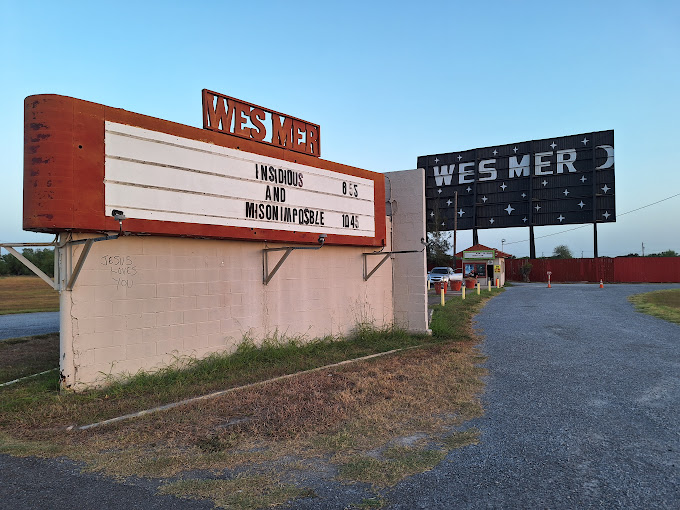
While there are only 400 drive-in movie theaters left in the U.S., one South Texas drive in is celebrating a big milestone, with no plans to slow down. If you ever passed through 2090 W. Business 83, you likely saw the Wesmer Drive-in. What you might not have known, however, is that there are 73 years of history behind that screen.The Wes-Mer Drive-In theater, named after its location, between Mercedes and Weslaco opened in early July 1950. Throughout Texas’s history, the state has been home to about four thousand drive-in theaters, but now about 20 remain, and one sits in tiger town.
“Congratulations To The New Wes-Mer Drive-In Theatre,’’ the newspaper’s full-page ad said on July 6, 1950. The first movie shown on the Wes-Mer’s big screen was Everybody Does It. Don’t miss it! The Enterprise ad printed about the opening night movie experience.
Wes-Mer opened in the late 1940s, histories of the Wes-Mer state that its first owner was Jewel Archer, who also owned the Sky Vue Theatre in Elsa, which opened in 1949. Archer and his wife owned the Wes-Mer until 1956, when they sold it to Lew Bray, the district manager for interstate’s Rio Grande Valley theaters. Hector Benitez, a pioneer in the RGV Movie theater industry and member of the Will Rodgers Motion Pictures Pioneers Foundation owned the theater between the 80s and 90s. His love and passion for the cinema began at an early age through his parents, who brought the first silent movies to Weslaco. From there, he and his brothers owned and operated numerous movie theaters and drive-ins throughout the Rio Grande Valley. Wes-Mer was purchased by Hector Garza in 2004. News accounts reported that he grew up going to drive-in theaters in South Texas and owned outdoor movie venues in Mission and Falfurrias. He revived the Wes-Mer and it is still open and going strong today under the direction of Lydia Garza.
A movie projector donated by Mrs. Benitez along with a collection of photos displaying the carloads of people at the theater are displayed in a permanent exhibit at the Weslaco Museum.Joe Vidales, a local expert historian and longtime museum volunteer, said “These types of images are priceless because we don’t have that anymore.”
More than 70 years after its opening, the big screen of Wes-Mer still stands between two Mid-Valley cities, with carloads of families still lining up to enter its historic grounds. After all these years, Garza said in a TV interview “there is (still) nothing better than watching a movie on a big screen under the stars, (with) a full moon’’ to keep everyone company. Admission prices on Tuesdays are $5 per vehicle and other days $10 per vehicle. To find a listing of movie showings go to wesmerdrivein.com.
You’ll find the beloved brand in homemade queso and nachos around the country. But it all started in Elsa, Texas.

In Texas, it’s been a pantry staple for generations: an essential ingredient in queso, nachos and in some cooks’ bowl of red. What many don’t know is that Ro-Tel, a concoction of diced tomatoes and chiles, was born in the Rio Grande Valley – and got a giant boost when a first lady put in in her Pedernales chili.
Interview Below:
Texas Standard: You begin your story for Texas Highways by calling Ro-Tel ‘a brand synonymous with Super Bowl parties and southern casseroles.’ Do you have a personal history with those canned tomatoes and peppers?
Omar Gallaga: I have an ongoing love affair with queso, but I didn’t have a lot of awareness of the brand until I started cooking for myself as an adult. And even though I was born and raised in the Rio Grande Valley, I had never heard about the connection to the region, either.
Let’s dig into the history just a bit. Where exactly did Ro-Tel get its start?
Well, the brand was started in 1943 in the town of Elsa by a man named Carl Roettele. He was an entrepreneur who used locally grown vegetables and two local canning companies to start the Ro-Tel brand. According to people I talked to in the town, there was a factory in Elsa and one in nearby Donna. And the ingredients, including onions and tomatoes, were all grown in the area. And one of the people I interviewed said that when the factory was going, you could smell the vegetables cooking in the air.
But it didn’t seem to really become a big thing statewide, I guess, until Lady Bird Johnson picked up on this. And she had a recipe book or something?
She had several recipes that were published. I believe the first one that really made it take off was one for Pedernales chili that was published in The Washington Post in 1963. And the brand was already growing; it was already expanding to other cities in Texas – San Antonio, Dallas, Austin. But that endorsement really is what took it national. That really made the brand explode, when they got the endorsement from the First Lady.
And it still has a lot of fans to this day. But I think of it as almost a mid-century kind of comfort food or something.
Yeah, but it’s always been around, and it really seemed to have a resurgence. The company told me that they really saw a big sales boost during the pandemic when people were relying on slow cooker recipes and doing more food preparation at home. The company that owns it told me that they sold about 172.9 million cans of Ro-Tel over the last year when I talked to them at the end of 2022.
So what is it about Ro-Tel? I think a lot of people would wonder, what’s the thing about diced tomatoes?
I think people just grew up on it. I mean, it was such an easy way to not have to cut or roast your own vegetables – to just kind of dump them into a recipe. Just the ease of it, and it just sort of became a staple.
I talked to Conagra. They’re an international food brand that bought it. They said the brand is just beloved. I mean, a few years ago, they even came out with a Quesobago truck that toured the country, went to tailgate events, sharing queso recipes, kind of doing like a Wienermobile type of thing. So they’ve got a lot of fans, and they’ve done a lot of fun stuff with it.
See, I think the secret here are the green chiles – having those green chiles with the diced tomatoes. They taste stewed together already, right out of the can.
Yeah. And they came out with several variations. There’s a mild, there’s a spicy. I mean, it’s not just the one variety.
They’ve got a whole website dedicated to recipes just built around Ro-Tel.
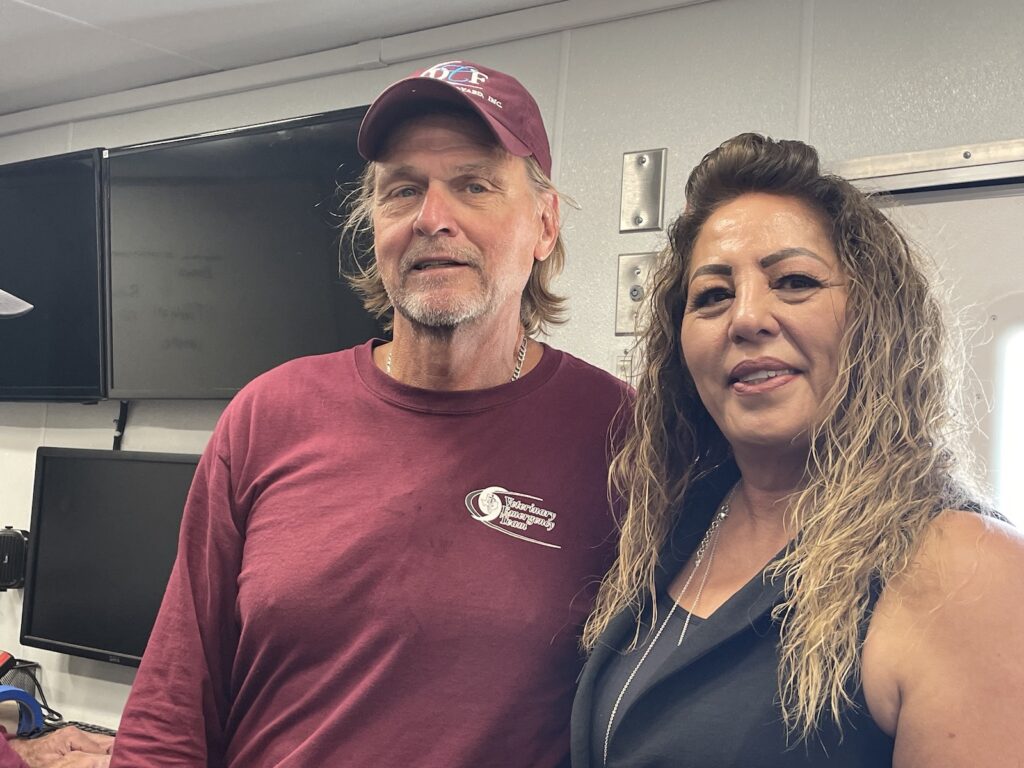
RAYMONDVILLE, Texas – A pet clinic the Texas A&M University Veterinary Emergency Team had in sparsely populated Willacy County wasn’t what the Aggies were expecting.
The five-day operation had to be cut short by 10:30 a.m. on its last day because of an unforeseen development: the men’s and women’s best friends outnumbered the vaccines available for the free-to-the-public event.
A total of 1,022 house pets, mostly dogs, were treated by a staff of about 80, some of whom were third- and fourth-year students from one of the nation’s top universities.
This School of Veterinary Science ranks sixth in the United States and 11th in the world, according to the 2022 Quacquarelli Symonds World University Rankings by Subject.
Dr. Wesley Bissett, the VET program’s director, said he thought they came prepared for the clinic but the response they got from the Rio Grande Valley was overwhelming.
“It was an amazing. We practically doubled the numbers,” he said. “The only negative aspect of the operation was we ran out of vaccines and had to shut it down a little too soon.”
Bissett said they more than doubled last year’s figure of 502 pets and had 292 more than the 730 they treated in 2021.
Some of the wellness preventive healthcare services available for pets included rabies vaccines, distemper/parvovirus/adenovirus, Type 2/parainfluenza and leptospirosis vaccines, feline rhinotracheitis/calicivirus/panleukopenia and leukemia.
Also, physical exams and low-level diagnostic testing for conditions like heartworms and tick-borne diseases. Some pets were eligible to receive a dewormer and a single dose of heartworm and flea prevention based on their age, health status, and previous health history.
Bissett said they will be back next year and anticipate the same, if not higher numbers.
But to cope with an increased number of pets they will have to acquire more supplies.
The cost of the five-day operation is a $120,000 price tag, but the benefit the community receives is almost four times as much.
Some of the funding the A&M team has for its clinics comes from donations such as from the Banfield Foundation – a Washington State-based non-profit organization that provides disaster relief for pets, among other things.
Bissett said he wishes the Texas Legislation would introduce a bill to allocate funding for such operations, adding nothing has yet happened.
The free pet clinic was part of the annual Operation Border Health Preparedness – a full-scale emergency response in case a health emergency situation hits the region.
The Texas Department of State Health Services is the lead agency in charge of the 20-plus years program.
It was formerly known as Operation Lone Star but it changed name two years ago to avoid confusion with Texas Gov. Gregg Abbott’s border security initiative.
The week-long event is a full-scale operation set up to respond to natural or man-made disasters and it provides dozens of health care services to people and animals living in the Valley and Webb County.
Willacy County is the only place where the pet clinic has been held for the last three years.
OBHP has been taking place in one of the most economically-distressed regions plagued with high unemployment rates and low per capita income.
According figures issued by the Federal Reserve Bank of St. Louis, the RGV has one of Texas’ highest unemployment rates, ranging from 5.7 percent in Cameron County to 9.3 percent in Starr County, compared to Texas’ rate of 4.1 percent.
The figures are as of May is this year.
For hundreds of RGV residents OPBH is a yearlong wait worth every penny.
Raymondville resident Corina Cantu said she could not be happier to find out the operation was coming back to town this past July.
“I wait for this to happen all year long,” she said. “This is the only place I can really afford to take my little dog.”
A Weslaco resident, who moved from the Mid West several years ago and who has no health insurance, said she gets health services for herself and her dog, which she rescued from a local animal shelter.
Countless people from all over the RGV showed up for the free pet clinic, including Robert Salinas, the county’s building inspector.
“Very beneficial,” he said, referring to the four dogs he took to the clinic.
Estella McKee, chief of staff for the state Rep. Janie Lopez, toured the portable vet hospital.
“I was really impressed with all the information they had available, she McKee said, “whether inside or outside (the buildings).”
All the OPHP services are free and open to anyone from the RGV – whether ricos o pobres, gatos o perros.
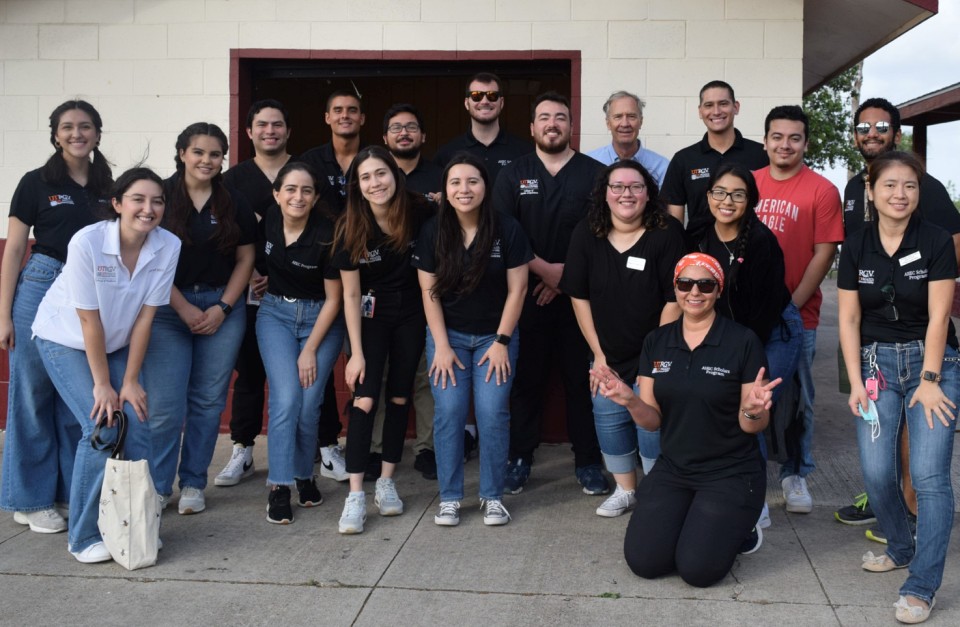
RIO GRANDE VALLEY, TEXAS – JUNE 14, 2023 – UTRGV’s Area Health Education Center (AHEC) Scholars Program is training about 90 students to help increase access to healthcare in underserved communities in Cameron, Starr and Hidalgo counties.
Established in 2016, the Scholars Program prepares UTRGV students in health-related majors to work effectively in interdisciplinary collaborative teams in primary healthcare. AHEC Scholars serve at each of the UT Health RGV AHEC sites located in rural and medically underserved areas in the Rio Grande Valley.
The goal of the program is to educate medical students from the UTRGV School of Medicine and other health-related disciplines about the social causes of health-related inequalities.
“Nationally, there's a shortage of primary healthcare providers. In South Texas, the shortage is greater, not just for physicians but physician assistants, nurses, social workers, addiction counselors and other health professions. That is why our AHEC Scholars Program is crucial,” said Dr. John Ronnau, senior associate dean for Community Health Partnerships and AHEC program director and principal investigator.
Since 2016, the program has produced more than 230 AHEC Scholars.
Seven different disciplines make up the AHEC Scholars Program and all work together to serve AHEC communities:
- Physicians.
- Physician assistants.
- Nurses.
- Dieticians.
- Addiction counselors.
- Social workers.
- Exercise science.
“We emphasize getting students to think about how other disciplines would approach challenges and opportunities and work together to meet the needs of patients and the community,” Ronnau said. “It has an impact on how they are going to practice, both now and in the future.”
TRAINING FUTURE HEALTHCARE PROFESSIONALS
Sabrina Orta, a 2023 UTRGV School of Medicine alumna and AHEC Scholar, who matched to the Vanderbilt University Medical Center pediatrics residency program, said the program empowers both the students and patients.
“I wanted to interact with the RGV colonia community to improve patient health literacy, provide public awareness and encourage patient empowerment in medical decision-making,” she said. “I knew I would mutually benefit by practicing my Spanish and building my experience of working with community partners to undertake public health initiatives.”
Caleb Mata, an AHEC Scholar pursuing a degree in exercise science, said the program has been an eye-opening experience that has allowed him to collaborate with others.
“I served the community through my time at the AHEC at La Victoria in Starr County,” Mata said. “Together, my team and I learned about the unique access challenges faced by rural and underserved communities.”
Orta and Mata both earned AHEC Scholar Program certificates and gained experience by completing a total of 160 hours each serving at the AHEC sites.
COLLABORATIVE EFFORTS
Ronnau said there are more than 100 AHEC programs throughout the country, but UTRGV is one of only a few that includes primary healthcare.
The UT Health RGV AHEC staff are funded by the federal Health Resources and Services Administration, or HRSA, and the UTRGV School of Medicine, to provide primary care, acute and chronic illness care, health screenings, physical exams, immunizations and preventive care.
“There is a need for primary care in our rural South Texas neighborhoods and we serve them at reduced costs,” Ronnau said. “We have integrated our AHEC training program into those clinics, so while we serve community members, we also provide educational opportunities for students and training for residents.”
The UT Health RGV AHEC Primary Care at San Carlos in May expanded its services with a primary care annex designed to better serve the needs of that community. The expansion was part of a collaboration with Hidalgo County Precinct 4.
The AHEC Primary Care Clinic at San Carlos is just one of three AHEC’s where UTRGV Scholars and residents serve the rural Rio Grande Valley community.
“With this expansion, we will serve more potential patients, not just in San Carlos but in the surrounding areas,” said Dr. Michael Hocker, dean of the UTRGV School of Medicine and senior vice president for UT Health RGV. “We are demonstrating what a benefit it is to have an academic medical institution in the region providing educational, clinical and research opportunities our communities can directly benefit from.”
The three AHEC clinics across the Valley have provided more than 25,000 patient visits to more than 8,000 people since opening their doors. The new San Carlos clinic annex will help serve about 500 additional patients each year, with staffing, residents and other support from UT Health RGV.
To learn more about the AHEC sites and AHEC Scholars Program visit https://www.utrgv.edu/school-of-medicine/about/community/area-health-education-centers/index.htm.
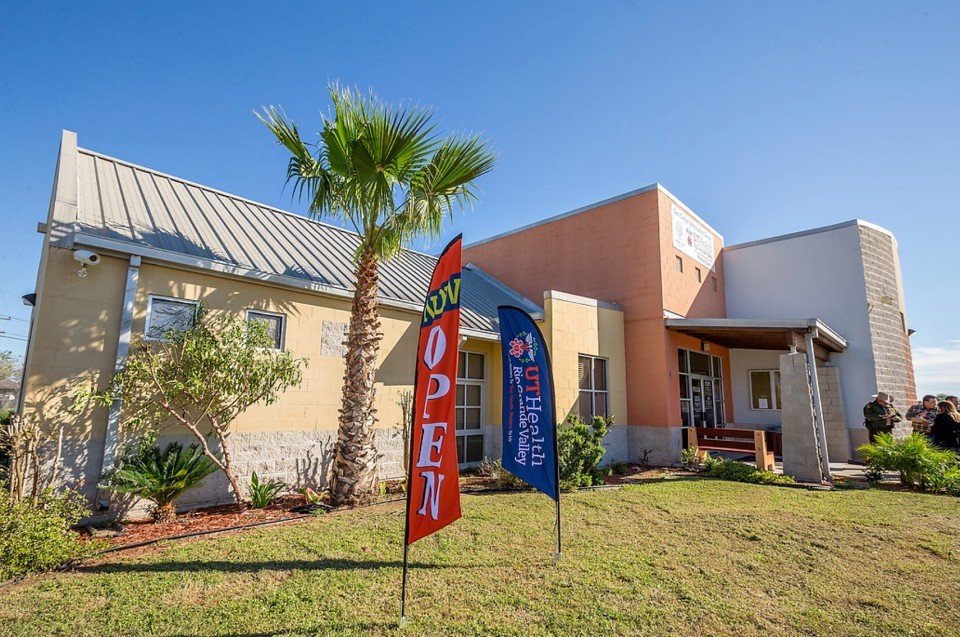

The entryway to a 1930s building located off Main Street was ripped apart. The paint on the banister — paint that was decades old — was stripped away, revealing the original wood. Through the distress of the renovation, the building seemed to sag. The weight of many years of neglect was almost tangible. But there was something stirring in the beams — the bones that held this building together. It was as if the building was taking a deep breath, ready to exhale many more years of life.
Marc and Angela Millis have been renovating old properties in McAllen’s historic district for several years. The couple restores the buildings and leases them to small business owners, allowing them to flourish in the beautifully renovated spaces. They have also worked on several residential projects, including apartments, lofts, and houses.
“We don’t tear down these houses,” said Angela as she carefully tiptoed over boards. “It’s like every person has a story. Underneath the layers we mask ourselves with, there’s a true authentic story to us. Every house has its own authentic story, too. It’s kind of neat.”
Among their notable commercial work includes Southern Roots, a fresh flower market. The beautiful building kept most of its historic integrity, as many of the Millis’ projects do. A newer renovation is Modern Vintage, with beautiful original beadboard and wooden floors. The building is now a vintage boutique, holding even more historic elements within. Both stores are located on Main Street in McAllen.
Every project is given a name, and one in particular — “The Beast” — earned its moniker due to being in such bad shape. But with hard work and lots of attention to detail, she has become “The Beauty.”
The large two-story building is located at 321 N. Main Street and was, for a long time, a men’s boarding home. The building looked worn as the sun beat down on it. The blighted property has been standing since the 1930s and holds so much history, but over the years, had been neglected and had lost its original charm.
The couple has a team of construction workers and works with structural engineers to ensure the safety of the construction. The inside of the building was gutted. What once was sectioned off into many boarding rooms and a community bathroom is now an open space with an office and a large photography studio upstairs. A large window was added for natural light, and custom-made duct work gives this modern vintage style an industrial flair.
“The historical significance that this building has seen on Main Street of McAllen — it just wouldn’t feel right to scrape it and build new,” Marc said. “I think it’s important for cities and leadership to understand that preserving buildings and structures that have a historic significance draws people in.
“People are drawn to the energy from way back that you can’t replicate from a new structure.”
The couple has been renovating buildings since 2013. Their first five-year goal was for Marc to leave his corporate job, and that opened up the opportunity for them to work together and do what they enjoy: breathing life back into old properties.
“It’s not about us, it’s about what we’re bringing back to the community and what she (The Beast) is now going to add here,” Angela said. “New stories will be created so that over the next 20 to 50 years, people can continue enjoying these pieces of history.”
The couple hopes to see Main Street become even more walkable, opening opportunities for people to get outside and walk from boutiques to restaurants.
Much of The Beast’s original materials were kept. From the original hardware to original glass taken from old windows and re-used on smaller windows, every bit of the home is salvaged and renewed. The banister was scrubbed down, sanded, and sealed — the veins of the original wood noticeable once again.
The exterior kept its original 90-year-old wood for the most part, and all the windows are now double-paned. Large piles of wood taken from around the home were salvaged and used throughout the building’s exterior and interior.
The team even found a Bible hidden in a wall. They decided to place it back, framing it so it can be seen. Unsure of why it was placed there in the first place, Angela could only speculate that somebody needed it at one point in their life.
“That’s what makes it so special when you find things like that,” she said. “You’re giving life, a pulse back into these homes.”
Hope is given back and the sad energy that was palpable in the home slowly began to lift. And just like people, homes are a work in progress. Whatever “The Beast” was in the past, she is no more and cannot be defined by that. This restored building is now the new space for Nicole Gates Photography Studios, where families, brides, and professionals will come and have their moments in history captured.
“I talk to the buildings and say, ‘We are going to bring you back to your original glory,’ and she (The Beast) has shown up,” Angela said. “It feels like she is smiling again.”
Over the course of this home’s life, it has kept many stories, and now she is ready to create new ones, retelling old ones in the process. She is a part of making Main Street vibrant and inviting.
“We’re bringing life back to downtown McAllen that for a long time has had a negative stigma,” Angela said. “We hope to bring it all together. This historical puzzle we’ve been working at for many years will be something for generations to see and enjoy.”
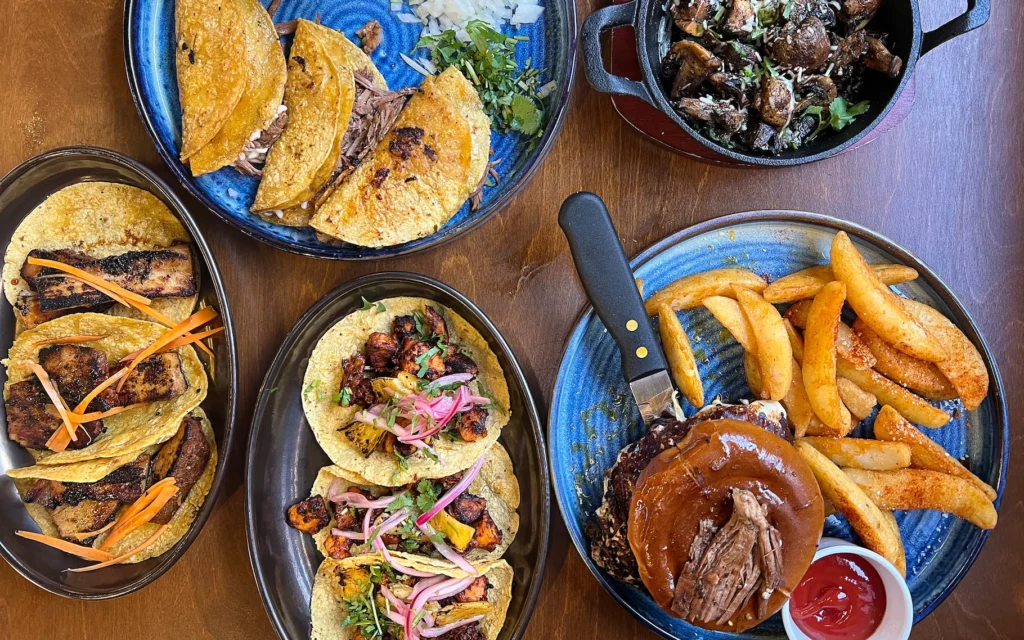
Evin Garcia grew up in poverty and food insecurity in the small Rio Grande Valley town of Mission. His earliest memories of cooking are of when the kitchen cupboards were nearly empty and he was challenged to be creative with whatever he could scrounge up. He remembers one day when he collected enough ingredients to make pancakes for his mother. “She said they were the prettiest pancakes she ever had,” he says. “I like that I could feed her and make her happy.” He grew accustomed to making “something out of nothing,” as he describes cooking in his youth.
Garcia’s ingenuity and love of cooking for others continued as a young man. He traveled to places such as Taiwan, Kuwait, Nigeria, and Australia as a shutdown specialist and industrial mechanic for Chevron. Wherever he was, he’d cook for his crew with whatever provisions they could gather, which helped them bond. It was also a respite from the work—taking a rig or refinery offline and removing fuel, chemicals, or heavy equipment, such as reactors—that wore out Garcia’s body. Eventually, he wanted out, wanted to return home, wanted to cook, and wanted to give back to his community.
La Cocinita is the sanctuary from which he shares his good deeds and food that nourishes not only the body but also the spirit. It opened in June 2021 in the Mercado District food hall in McAllen. “My path is making people happy and helping others however I can, and cooking has always been a passion of mine,” Garcia says. “God blesses me so that I can help bless others.”
At the food stall, Garcia likes to work the cash register, strike up conversation, make people laugh, and perhaps make new friends, all while not letting customers know he is the owner. “I want to make people smile, man,” he says.
La Cocinita is tucked away in the far right corner of the building, but the location of the kiosk doesn’t prevent lines from forming. I broke my own rules of taqueria ordering by allowing a line to form behind me as I lingered in conversation with Garcia. During our chat, Garcia showed my friend and me a package of locally sourced nixtamalized tortillas from Tortilleria San Agustin in Palmview, west of McAllen. He answered questions about the taco names and preparations. For example, the Taco San Manuel is named after Chorizo de San Manuel, the producer of the dish’s juicy jalapeño, cheese, and cilantro sausage, in nearby Edinburg.
As we spoke, Garcia mentioned the international influences in the ingredients and cooking techniques that he picked up from his time as a shutdown specialist. As much as he liked the tricks and tips he’d taken in while working for Chevron, Garcia knew the key to making his restaurant successful would be adding a Mexican twist to what he had learned abroad. For him, that was best done with the taco. “I feel like everybody knows what a taco is—the taco is universal,” he says.
It’s not enough for Garcia to feed paying customers and make them laugh, though. He feels a responsibility to feed whomever he can, but he can be uncomfortable talking about it. Garcia tells me he’s discussed his community outreach with only a few others. “God’s seeing it,” he explains.
But since he’s dedicated so much of his time to helping others, it’s important to share how impactful Garcia really is. “Instead of throwing away food, I feed the homeless, because as a kid, [my family] never had it,” Garcia says. “There are so many people out there who don’t have money for food. I want to give it to them.” Sometimes the taquero gives unhoused people rides or takes them out to eat and just talks and listens. He holds toy drives, saying that sometimes even a five-dollar toy is enough to give people hope. It might let them know someone cares. Garcia is currently arranging with nuns in the Rio Grande Valley to assist in the feeding of migrants. The taquero also sponsors local mixed martial artists who train at a friend’s gym by helping them get to their desired weights, so they don’t have to worry about buying extra food. For Garcia, the tortilla-wrapped treat some of us take for granted is also a force for good.
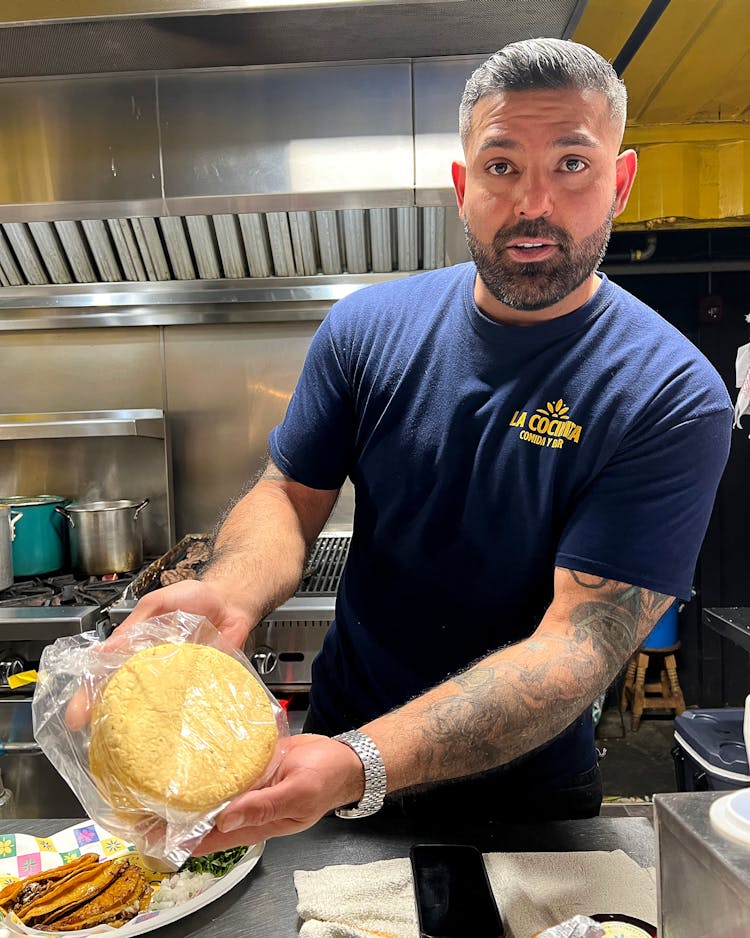

Two of those tortilla-wrapped treats are the taco de chicharrón prensado, with a costra blanketed in a peppy salsa verde, and the taco with papaya-rubbed fajita, which retained a hint of the bright flavor imparted by the tropical fruit. One example of Garcia’s global culinary perspective is his chicken taco. The poultry is grilled on an open fire in the style of peri-peri chicken. The dish, which he learned to make while working in Australia, is believed to have been originally created by Portuguese colonists in southern Africa. It’s charred, lemony, and garlic-forward, with a penchant for frying taste buds with an intense—sometimes unrelenting—spice. Garcia toned down the capsaicin by replacing African bird’s eye peppers with chiles friendly to the Mexican palate. It still had a heckuva kick, one that required a cautious approach. Thankfully, the heat never overpowered the chicken or the other components.
As tasty as those tacos were, the pulpo al pastor was a misstep. At first glance, it seemed reminiscent of Revolver Taco Lounge’s flamethrower-blasted octo-trompo. Garcia’s approach to preparing the cephalopod, however, is Iberian in inspiration. Yet despite the use of a technique Garcia learned in Portugal, one in which the cook repeatedly lifts the octopus out of boiling water to soften the meat and remove the fishiness, the charbroiled Spanish octopus marinated in al pastor adobo retained its fishy taste. The flavor tore through those of the wedges of grilled pineapple and fine threads of onions.
Menu items that get their inspiration closer to home include the Nuevo Progreso–style lonches. Lonches are sandwiches made with small, crunchy bolillo rolls that are split open at the top and filled. In the Mexican border city of Nuevo Progreso, that filling is typically picadillo, with onions, cilantro, and salsa. However, any filling will do, and Garcia allows nearly every option for his lonches. Especially good were the threads of chile-and-spice-infused birria, which in this case is beef shoulder. That’s the only deviation from the recipe the taquero picked up during a visit to the city of Tequila, in birria’s home state of Jalisco.
The preparation is adapted from that of a goat birria served by Maria de Soto, a woman who operates a stand in one of Tequila’s mercados. The knowledge came from a chance but profound encounter that illustrates Garcia’s sense of community. When he expressed how much he liked the birria, de Soto offered to give Garcia the recipe to take back to McAllen. He declined. Instead, he offered to pay de Soto for her knowledge. She, in turn, declined his offer. “I told her, ‘Let’s help each other out. It’s the right thing to do,’ ” Garcia says. She finally accepted. “We still talk and I help her out sometimes,” Garcia adds. “I call her tía now.”
In November 2022, Garcia opened a freestanding brick-and-mortar spin-off, La Cocinita Comida y Bar, which I visited the day after my stop at the food hall. The full-service restaurant was spacious, with personal touches like a dried and varnished cactus as a stand for a glass table, something I had never seen before. Also different was the pulpo al pastor, among the other good dishes I ate during my time there. The pulpo’s fishiness was absent. In its place was the intended charred, earthy, and slightly spicy al pastor marinade. It was so wonderful, I have to confess, I was momentarily reluctant to share the plate. Then I looked across the dining room at a boisterous baby shower attended by women speaking Spanglish and passing around large platters of tacos. I saw a familiar joy, one that evoked kinship, fellowship, and tremendous smiles. I recalled Garcia’s words: “Eating together is a catalyst for joy.”
La Cocinita Mercado District
4400 N. 23rd, McAllen
Phone: 956-534-6600
Hours: Sunday 11–5, Tuesday–Thursday 11–10, Friday–Saturday 11–11
La Cocinita Comida y Bar
5921 N. 23rd, McAllen
Phone: 956-686-6686
Hours: Sunday 10–5, Monday–Thursday 10–10, Friday–Saturday 10–11

Relationships make the world go ’round. Good, positive, healthy, meaningful, happy relationships provide us with the richest experiences we have. Your loving spouse who shares everything with you, that best friend who connects with you like few others do, the people at work who appreciate you and help you become the best you can be—they bring joy to life.
But relationships can also be the bane of our existence. What causes more pain in this life than a broken relationship, especially when it isn’t just broken but downright ugly?
So it behooves us to do all that we can to keep our relationships zipping right along. If we put our very best into our relationships, we can almost guarantee getting the very best out of them, too.
Characteristics of a healthy, happy relationship
There are three things that, when done over time, begin to create the kinds of relationships that you truly desire, that you have always dreamed of. The key to remembering the three items that can improve any and all of your relationships is the acronym Z.I.P.
1. Happy relationships have ZEST.
Relationships should be fun. Think about it: Don’t healthy relationships start out with a lot of good times? Whether it’s going out to dinner or a ballgame, fun is a major aspect of your relationship. It’s part of the glue that bonds you together.
But as life goes on, the fun starts to fall by the wayside as it increasingly becomes about getting the job done, whatever the job may be.
To restore the relationship, to put a little zip into it, reintroduce the idea of “zest.”
What can you do to get the zest back if you’ve lost it? Think of a specific relationship you have. What were the fun things you did at the beginning of it? Commit to doing those things now—alongside trying some new fun things together—and see if your relationship doesn’t begin to soar again.
2. Cultivate more INTIMACY for a healthy relationship.
That is, taking your relationship to a deeper level.
That doesn’t mean you have to start engaging in group hugs with your workmates or having revelation sessions where the tissues flow freely. Every happy relationship that is mutually satisfying has a level of depth to it that provides meaning. And isn’t meaning what we search for in our relationships?
At the beginning of a relationship, time is spent opening up, telling each other who you are, where you’re from, what your likes and dislikes are. There is a deep sense of satisfaction with the relationship—that’s why it continues. You like who they are and you enjoy them knowing you.
But then something happens. We get to a certain level and the pursuit of depth ends. We stop sharing feelings and joys and dreams and fears. Instead, we settle into routine. The daily grind takes over and we stop knowing one another—we simply exist together.
Now, every time you get together doesn’t have to be deep—sometimes just having plain old fun is good, too. But there is also a need for regular intimate connection. After all, meaningful, happy relationships develop when others love and accept us for who we are at our core.
Think about the relationships you would like to see improvement in. Take some time in the coming weeks and months to really talk and get to a deeper level—to let the other person deeper into your world. You can’t force them to be more intimate and you certainly can’t say, “Let’s get together and have an intimate conversation,” because that would be too contrived. But you can make a decision for yourself that you will let others see more of who you are. Perhaps this will even be the catalyst for them doing the same.
You can guard yourself from intimacy, but then you won’t go much deeper in your relationships and you will feel a longing in your heart for more. Or, you can begin the process of deepening your relationships and see them change for the better.
3. Happy relationships share a PURPOSE.
The most meaningful relationships are those held together by a common purpose and vision for what it can accomplish.
When people have a common purpose, they feel bound together, like they are part of a team. Think about your strongest relationships. Aren’t they centered on at least one common purpose or goal? What about your weaker relationships? Think back and see if you used to have a common purpose that has since fallen by the wayside.
What about the relationships you want to grow? Take some time to begin to cultivate a common purpose. Sit down with that person and tell them that you would like to have some common goals that you pursue together. As you develop these, you will see your relationship strengthen in ways you never imagined.
Today is a gift that will be gone tomorrow; don't throw it away.

Ephesians 5:15-17 In his letter to the Ephesians, the apostle Paul shares how to walk wisely. In today’s passage, he gives three instructions. First, he says to “be careful how you walk” (v. 15). Because we live in a sinful world, we must be vigilant about how we think and act. Second, the apostle instructs us to make the most of our time (v. 16). So often we are tempted to squander our time and energy on our own pursuits without a thought of what our heavenly Father may have in mind for us. Third, Paul tells us to “understand what the will of the Lord is” (v. 17). In its broadest sense, God’s will for us is that we would each become the person He created us to be and do the work He planned for us (Eph. 2:10). Knowing this, we should look at every decision with consideration of whether our choice will further or hinder our heavenly Father’s purposes for us. The Lord wants us to walk wisely so that we can enjoy all the marvelous benefits He has promised in His Word. Wasted opportunities and time misspent can never be reclaimed. Let’s commit to make our lives count for Christ instead of merely living for ourselves.
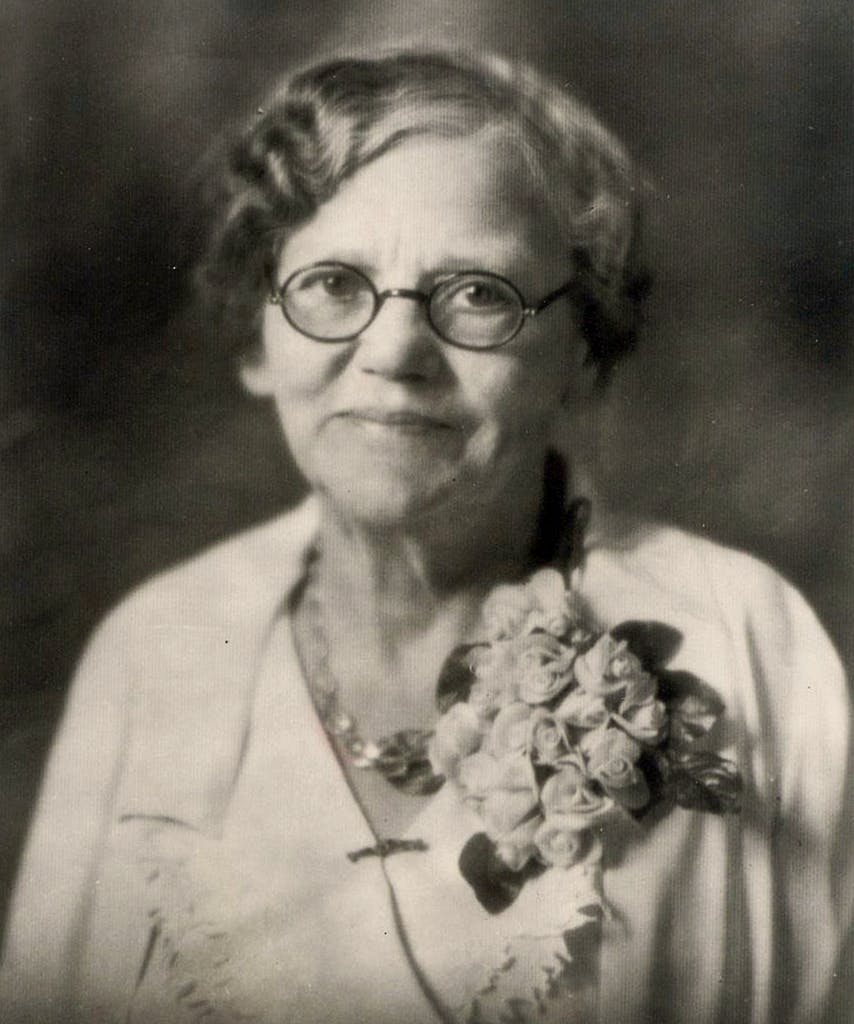
Like many Texans, I always assumed that Howard Edward Butt was the mastermind behind our state’s favorite grocery chain. The business is named for his initials, after all. Women tend to be relegated to minor roles in rags-to-riches stories, when their names are remembered at all—and it’s time to correct that. H-E-B—arguably the most beloved brand in the state, with roughly 430 stores and a well-oiled disaster-response machine that Texans trust more than the government in times of crisis—wouldn’t exist if it weren’t for Howard’s mother, Florence Thornton Butt, who opened the family’s first store, in the Hill Country town of Kerrville, in 1905.
She did so out of desperation. Florence’s husband, Charles Clarence “C. C.” Butt, fell ill with tuberculosis and couldn’t work; it was up to Florence to support the family, which included three young sons. In the days before antibiotics, prevailing medical wisdom held that tuberculosis could be cured through rest and exposure to fresh air in warm, relatively dry climates. Butt’s doctor had advised him to move to such a place. The family chose Texas—moving first to San Antonio, in 1904, and a year later to Kerrville, a half hour southwest of Fredericksburg. Today the town is a tourist destination, known for its spring wildflowers and summer folk festival—but a century ago it was a remote, rugged place where chronically ill Americans sought refuge. Physician George Parsons, from Chebanse, Illinois, had himself recovered from tuberculosis in the Hill Country town; he later wrote about his experience in a medical journal and started Kerrville’s first sanatorium, bringing still more patients hoping for a cure.
Florence Butt came to Kerrville with her husband, their three preteen and teenage sons, and at least one older stepson. Initially, the family may have lived in a canvas tent near the Guadalupe River. Tent camps were full of tuberculosis patients and their families trying to get adequate fresh air and sleep close to the ground, as doctors recommended. As she tended to her family in this primitive setting, Florence had to find a way to provide for her ill husband and her children in a town where she knew no one. In time, she would open a successful store, become a leader in the local Baptist church, endure the death of her husband and one son, and develop a reputation as a generous community leader.
Collings Guitars Are Worth Every Penny
“She perseveres,” says Joe Herring Jr., a lifelong Kerrville resident, a former mayor, and the town’s amateur historian. “And she does all this when she’s not even allowed to vote.”
Florence Thornton was born into a farming family in Buena Vista, Mississippi, on September 19, 1864, during the last year of the Civil War. Her obituaries say she graduated with honors and as the only woman in her class at Clinton College. (This might have been the now-defunct Clinton College in Kentucky, or perhaps Mississippi College in Clinton, Mississippi, outside Jackson—although the latter did not admit women at the time and does not have a record of her attendance.) She taught school and then, at 24, married Butt, a widower sixteen years her senior who ran a drugstore. Their wedding announcement in the Grenada, Mississippi, Sentinel describes him as an “accomplished gentleman and a popular citizen” and her as “a lady of rare intelligence.” The couple lived in Duck Hill, Mississippi, and Memphis, Tennessee, before C.C.’s tuberculosis diagnosis and their migration to Texas.
In Kerrville, Florence, then 41, initially tried door-to-door sales for the Great Atlantic & Pacific Tea Company, or A&P, which by the 1920s would become the largest grocery retailer in the world. She visited people’s homes to offer them a list of items they could order, which she would later deliver. At least once, a woman slammed the door in her face, saying she didn’t buy from peddlers. “Mother was a very refined woman, and this hurt her deeply,” her son Eugene later wrote.
Scrappy Florence Butt changed tactics. Stories about the original H-E-B suggest she opened the store with around $60 in grocery stock—equivalent to about $2,000 today. She rented a two-story wood-frame building on Main Street, near the Baptist Church (Florence was a devout Baptist) and Masonic Lodge (C.C. was a Mason), that had a few hundred square feet of space on the first floor and living quarters above. On this spot in 1905, she opened the store that became the first Butt family grocery enterprise.








